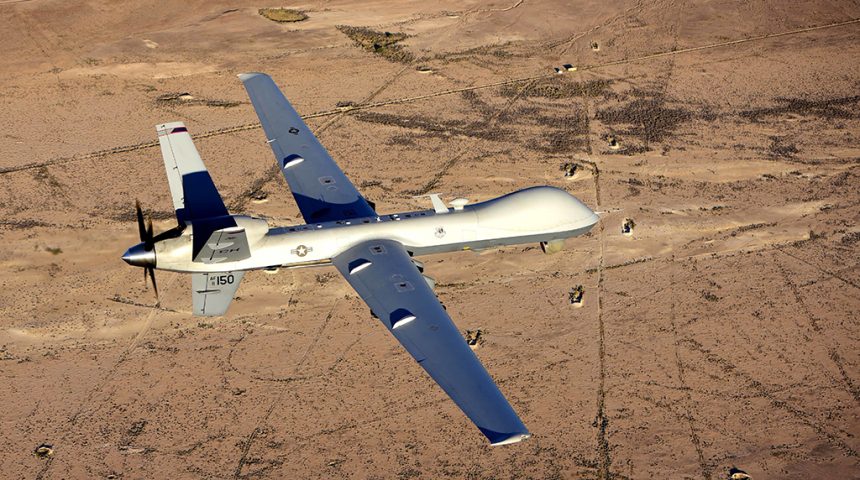Although it may well be just a coincidence, the loss of two drones suggests a new capability is available in Libya. Possibly provided by Moscow-backed mercenaries.
A U.S. drone was lost over Tripoli, Libya, on Nov. 21, 2019, a U.S. AFRICOM press release announced yesterday.
The aircraft, whose type was not unveiled, was taking part in operations in Libya “to assess the ongoing security situation and monitor violent extremist activity. These operations are critical to counter terror activity in Libya and are fully coordinated with appropriate government officials.”
Interestingly, the RPA (Remotely Piloted Aircraft) was unarmed. Two types of U.S. drones are known to regularly fly over Libya, the RQ-4 Global Hawks based at Sigonella Air Base, Italy (as part of the 7th Reconnaissance Squadron), and the MQ-9 Reapers, based both at Sigonella (as part of the 324th Expeditionary Air Reconnaissance Squadron), at the Nigerian Air Base 201, also known as Agadez Air Base, in Niger, and also at Larissa, Greece, where some U.S. MQ-9 were based (for sure until August 2019 although it’s likely their temporary deployment there has been extended). While the RQ-4s don’t carry weapons, MQ-9s usually carry PGMs (Precision Guided Munitions), although the examples based in Greece fly their reconnaissance missions unarmed.
US MQ-9 Reaper #drone at #Larissa Air Force Base in #Greece, March 19, 2019 https://t.co/iE1bIAUERH pic.twitter.com/zlkAZ8wfh1
— Wim Zwijnenburg (@wammezz) August 13, 2019
Anyway, it’s also worth of note that the U.S. drone was lost the day after the Italian Air Force lost another unarmed MQ-9A Predator-B drone southeast of Tripoli. According to the Italian Defense, the unmanned aircraft was flying in support of “Operazione Mare Sicuro” (Italian for “Safe Sea” on a route that was known to the Libyan authorities. Contact was lost with the UAV that eventually crashed several kilometers inland. Operation Mare Sicuro was established in 2015 to protect Italian national interests in the Central Mediterranean: it is a counter-terrorism mission to ensure maritime security. On Aug. 2, 2017 the scope of Operation Mare Sicuro was extended with the mandate to cover Libya territorial waters, in support of the Libyan Coast Guard, following a formal request by the Tripoli-based Government of National Accord (GNA).
However, the Italian version is denied by the Libyan National Army (LNA) spokesman who stated that the Italian drone was shot down by LNA force as it was deliberately operating in the area of Tarhouna, quite far from the Libyan coastline.
While both incidents are being investigated and no additional details have been disclosed, most sources seem to agree that the drones were not lost to enemy fire; according to unverified rumours, both were lost due to jamming, suggesting the deployment of systems able to disrupt signals used to control UAVs.
This could be the case. Not one but two drones for the first time since April suggests a new capability, and Wagner had been planning to send drone jamming operatives. https://t.co/qMv1GJH7Rb
— Samer Al-Atrush (@SameralAtrush) November 23, 2019
The drone jamming capabilities would have been provided by Russian private military contractors deployed to Libya to escalate the conflict and boost its influence there. Although Russia has officially denied its military presence in Libya, there have been numerous reports of Moscow-linked Wagner mercenaries operating on the ground around Tripoli.
“Forces loyal to eastern commander Khalifa Haftar launched an offensive this spring to seize Tripoli from Libya’s internationally recognized government. Russia is reported to be providing unofficial assistance to Haftar with the Wagner Group, a private army linked to President Vladimir Putin through businessman Yevgeny Prigozhin,” a recent article from The Moscow Times reported.
“Russia has invested heavily in electronic warfare systems which are capable of shutting down communications and signals across a broad spectrum,” the U.S. Army’s Asymmetric Warfare Group warned in a handbook it published in December 2016 that clearly highlighted the significant expansion of Moscow’s hybrid warfighting techniques. “The Russians layer these systems to shut down FM, SATCOM [satellite communication], cellular, GPS, and other signals,” The War Zone reported.
However, while breaking the link between the UAVs and their remote control stations can be an easy task for a category of small drones, jamming the signals used to remotely-pilot MQ-9 Reapers (that are guided via satellite data-links when BLOS – Beyond Line Of Sight), can be extremely more difficult. For instance, when officials said Russia was jamming U.S. drones in Syria in 2018, they explained that only small drones were affected: “The officials said the equipment being used was developed by the Russian military and is very sophisticated, proving effective even against some encrypted signals and anti-jamming receivers. The drones impacted so far are smaller surveillance aircraft, as opposed to the larger Predators and Reapers that often operate in combat environments and can be armed” NBC News reported.
However, jamming communication datalinks is not the only way to target drones: GPS jamming and GPS spoofing (i.e. deceiving and manipulating the satellite navigation system do provide false location data) are known capabilities of Russian man-portable and vehicle-mounted electronic warfare systems.
Was an Electronic Warfare attack the cause behind the loss of the two military drones last week? Maybe.
In conclusion, it’s unclear why two pretty advanced drones crashed two days apart around Tripoli but it’s totally possible that sophisticated anti-UAV technology made its way to Libya. And we will probably find out more in the next weeks.









